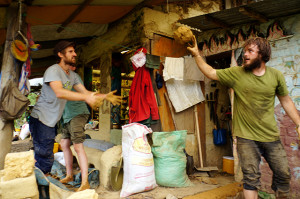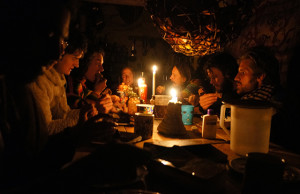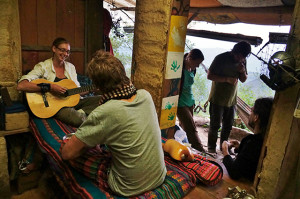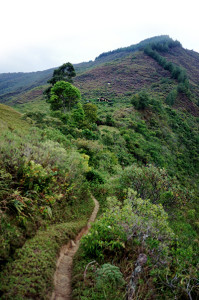Words + Photos By: William Pardoe, www.wheres-willy.com
Hippies burst into existence in the 1960s and created a huge wake in the culture of the time. By the 1970s, there were over ten thousand hippie communes in the US alone, as people were swept up in the peace and love ethos and getting back to the land. But what has become of the hippie today? Hitchhiking through Latin America last year, I found myself in a modern day commune in the Ecuadorian Andes.
Life in the commune
Glass jars sit on the shelves, harbouring mysterious yeast cultures. Suspicious concoctions and healthful potions are fizzing and fermenting; Kombucha in tea, Kefir in milk, and frothy sourdough starters. They sit nestled between bushels of broccoli, mounds of tomatoes, sweet potatoes and onions. A hundred bananas, enough for the week, are laid across a wooden beam. Books occupy the opposite corner, their dusty smell containing the wisdom of permaculture farmers, rustic chefs, and spiritual gurus. Everything here is brought up by horse, human or donkey – a steep two-hour hike into the mountains from the hippy hub of Vilcabamba.
There is a long table in this mudbrick room; a place for family meals and weekly meetings. There are no windows or doors to exclude nature – it is open to the mountain air and valley view, stretching out to the silhouetted peaks where the sun goes to sleep each evening.
Eleven of us sit around the table for lunch. The morning has been spent clearing pasture for the donkeys, feeding the chickens and collecting wild food from the “forest garden.” Work is complete and it’s time to enjoy the fruits of our labours. A big lunch is prepared, but before digging in, we hold hands and close our eyes. After a few deep breaths, a communal “omm” begins to resonate. With our voices reverberating in harmony, an energy fills the room. The release leaves a smile on everyone’s face, enjoying the peaceful energy for a few moments before opening their eyes, unless laughter erupts. A kiss for each hand and we tuck in. Sometimes someone would read a thought-provoking passage from a book like The Prophet. This is a hippie commune, after all!
After lunch, the rest of the day is ours. It is time to relax with a book, lie in a hammock, bake a loaf of bread or do some meditation. Time is enjoyed doing simple things or spent broadening the mind; books on the shelf outline the joy of living in the moment, by letting go of past and future and breathing enthusiasm into whatever task is at hand; be it pruning thorn bushes, or shovelling sh*t.
The people here are relaxed; a common side effect of walking around barefoot in the dirt, with a green mountain valley stretching out beyond your toes to the ever-flowing sounds of river and waterfall. Or perhaps it’s the curse of a day spent gently rocking in a hammock. They came as travellers seeking something more meaningful than the tourist trail; to settle in somewhere and really get to know the place. Some are passing through, volunteering for a few weeks, others have sunk their roots into this soil and are building their houses from it. They want to be part of its progress, to create a natural life by working with nature rather than money.
The commune started here ten years ago, taking a piece of land devastated by deforestation and cattle grazing, with the aim of rejuvenating it until it can fully sustain their needs. It’s a small-scale effort to reverse the damage we’re doing to the planet, and perhaps to learn post-apocalyptic farming for when the world has been ravaged and spent. The damage we’re doing to the land is telling, when after ten years of regeneration and fertilisation it is still degraded. As such, the community must hike most of their food up from Vilcabamba, with the intention of being self-sustained by the land within five years.
The hippies of today
The word “hippie” probably conjures images of psychedelically painted VWs, drug-fuelled festivals and colourful flower power peace protesters. The movement has continued to evolve since the revolutionary, eccentric hippies of the 60s were celebrating their new-found cultural freedom. The characters atop this Andean mountain are more subdued; simply living life as they think it should be lived.
There are still those making a statement, of course. Return to the tourist trail and you’ll find what I call “hipsters” – the hippier-than-thou bunch. They flaunt Rastafarian dreadlocks, baggy trousers from Nepal and a Guatemalan satchel like it’s Gucci. It amuses me that these “non-conformists” are conforming so eagerly to their stereotype. The hipsters of today drape themselves in greens and browns – if you rock up in wild 60s multicolour, then you’ll be seen as conforming to the stereotype! The term for these fickle fashionistas is “hippycrite.”
Fashion aside, the “Peace and Love” philosophy survives. Many follow a Buddhist mindset of meditation and spirituality. Peace is at the heart of the hippie mentality — something far more worthwhile to attain than money or possessions. Those at the commune are wealthy in time and tranquillity. Vital to the success of the community is love, which often comes from meditation itself. Inner peace shines outward.
The hippie culture is alive and well.
Tempted by life in a commune? A quick Google search of Hare Krishna or Hippie Commune and the intended location will give you a head start. It could be the adventure of a lifetime!





